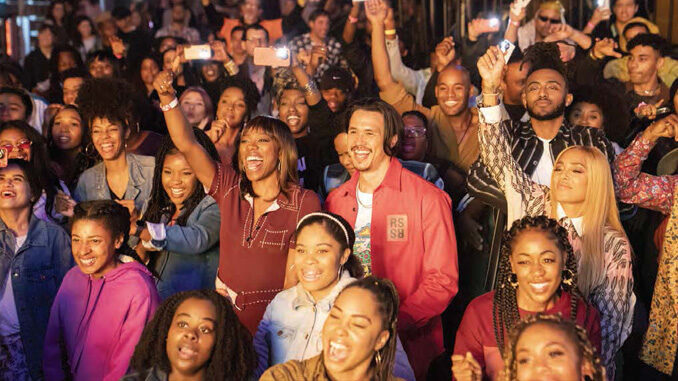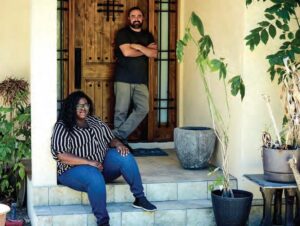
By Su Fang Tham

HBO’s millennial dramedy “Insecure” returned this spring to explore the fractured friendship between Issa (played by series co-creator Issa Rae) and her BFF, Molly (Yvonne Orji). Season 4 opened with Issa’s jarring declaration that she no longer deals with her best friend of many years, an earth-shattering notion for anyone who has followed their messy and tender friendship for the past three seasons. As each woman goes about her own way through much of the season – with Issa moving closer to ex Lawrence and busy planning the Market Street Block Party, while overworked Molly tries to figure out the next steps with boyfriend Andrew – the ominous tension hovers through much of a season told mostly in flashbacks as the catalyst to the blow-up slowly unravels.
We recently caught up with the editing team to talk about the challenges in picking out the best takes from a cornucopia of exquisite performances, and how Molly’s downtown apartment “sounds” different from Issa’s Los Angeles abode. Here are some excerpts from our conversation with editors Nena Erb, ACE, and Daysha Broadway, assistant editors Lynarion Hubbard and Aric Lewis, and sound effects editor Michael Sana, MPSE. In July, Erb and Hubbard were nominated for Emmys for their work on the show.
Q What was it about editing that lured you into the craft?
Erb: When I was promoted to Associate Producer in post at Oxygen, the editor I worked with – Sven Nilsson – changed my life. The way he shaped a story or changed the tone of a scene with just a few clicks – that blew me away. Editing combines storytelling, photography, problem-solving – everything I love all in one.
Broadway: Editing is a great mix of technology and creativity. When I was a kid, I loved Robert Zemeckis’ “Who Framed Roger Rabbit” – the blend of animation with live action characters and the technology he used in the “Back to the Future” films fascinated me; that drove me into the lane of editing.
Lewis: I started out in creative marketing and switched over to reality TV before landing at a commercial house working on an indie feature. In freshman year, I learned Avid and was hooked from the start.
Hubbard: I was in a television production program in middle school and they taught us editing – we were responsible for a morning news program. In under-grad, I worked on several shorts while majoring in film and broadcasting, and really enjoyed the narrative side of it. So I went to AFI after that.
Sana: When I was growing up, I was always playing with sound and would sample on tape. Whenever I found anything cool in the movies, I would record the sounds to make a collage. In junior high, I started DJing too. I met Mark Kamps [supervising sound editor at Technicolor] when I took his editing class at UCLA Extension – he was a mentor and inspired me to keep pursuing this.

Q What is it like to work on something of which you were already a fan?
Broadway: Watching Season One of “Insecure,” I thought “That’s why I got into this industry – to create this type of content!” So when I joined this season, I had already studied the show as a fan and knew how the show was cut, the visual style and comedy pace.
Q What is the show’s signature visual language?
Erb: When I got the job, I re-watched every episode to study what kind of music they use, when they bring music in, how they use transitions, and what wide shots of L.A. they use for the transitions. Issa’s scenes were shot more with hand-held cameras whereas Molly’s were more locked off because she’s more established in her life and career.
Hubbard: I felt very much at home – they were speaking my language. I was already a fan of the web series [“Awkward Black Girl”], so I related to the show on many levels.
Lewis: In terms of lighting, we always put our cast in the best light – everyone looks great, the city looks great. We have some shots where things are off-center or pushed to the frame, that’s been part of the visual language from the beginning. Q What is the process from dailies to final cut?
Erb: When I break down each scene – I’m looking for the heart and tone of the scene, what’s the one thing I must get across. With dailies, I read that segment of the script again, paying extra attention to screen direction in between the dialogue. The writer’s intention informs my decisions on performance, pacing and rhythm.
Hubbard: I usually accompany Nena to the table reads and start making notes then. I organize the dailies into bins the way she likes them so that we can move quickly – she only has a couple of days to hand over the first cut. For each scene, I also script sync it and add any ad-libs into the script; that way, she has everything transcribed.
Lewis: When I’m the assistant, I prep the dailies for [editor] Mark [Sadlek] to cut, making sure he’s aware of anything different in a take. Once he’s done, I do the temp sound while he scores the music. When I’m editing a sequence, I look at the dailies differently – now I’m looking more for performance, where the turn is going to be and subtext. When I’m cutting, it’s about story, story, story.
Erb: Aric is a VFX genius. In “Lowkey Done,” the beautiful wide shot at the intersection where Issa first sees George running across the street to catch the bus, that wasn’t how it was shot.
Lewis: Issa’s car and another car on the side of the street weren’t where we needed them. We had to duplicate the cars and slide them over to make that scene work. We also had to “rotoscope” George when he ran across the street – he had to cross the frame in front of a car and there was a bus going by. So we had to cut around George as he’s moving across the frame.
Broadway: In “Lowkey Losin’ It,” Issa was frantically calling around to replace the headliner and was told the person she was looking for had been shot. Issa’s response: “Oooh phone got shot too?” – that’s the best line! So when I was choosing takes, I knew that had to get in! When she scrolled through her phone for contacts, I wanted it to feel frantic to maintain the pacing, but you also have to be able to read the screen. The cinematography of that sequence was terrific – the way she felt on the phone was isolating and frantic.
Q How do you create the sounds of Issa & Molly’s world?
Erb: Once I’m done with a scene or episode, I’ll give it to Lynarion so she can do sound design while I score.
Hubbard: I’ll add ambient sounds for each location – the streets, inside a restaurant or a room – to give it more energy. I also adjust some dialogue to make sure levels are evened out and add sound effects.
Erb: This gives our sound effects editor Michael an idea of what we’re aiming for so his team can recreate it with a higher quality audio file.
Sana: I build the ambiences to set the mood. Molly’s apartment is in a downtown luxury high-rise, so there’s a lot of traffic, horn honks and sirens. Issa’s apartment has a different sound to it, there are birds because she lives on the hill in a neighborhood. The traffic sounds here are more muted, I’ll add crickets for nighttime, or birds, if it’s daytime. The room tone helps smooth over the dialogue or fill in the gaps when there’s a break in dialogue.
Erb: Our music supervisor, Kier Lehman, sources from music from mostly West Coast artists, ideally from South L.A. this is all newly released or previously unreleased music that is scheduled to be released at the time the episode airs. It’s a very complicated dance – it’s gotta have the right vibe, tone and lyrics to match the scene!
For a look at the music editing on “Insecure,” click here.
Q How do you find gems in a sea of masterful performances?
Erb: I developed this habit from working on nonfiction – I watch every single frame of the dailies from before the slate is clapped and after they yell “cut!” I’ve often found great moments I can use in between the resets. Sometimes all it takes is half a second of a frame that’s a gem.
Broadway: In the “Lowkey Losin’ It” episode, I maintained the tension with pacing and reactions to the dialogue. This episode was about what they’re NOT saying to each other – Issa is talking to Kelli (Natasha Rothwell) while Molly talks to Tiffany (Amanda Seales), but they’re not speaking to each other. Yvonne and Issa both say so much without uttering a word, that really helped when I was choosing cutaways and reactions.
Lewis: Issa, Yvonne and the cast know the characters so well, they’re nailing so many of these takes that you have an abundance of material to choose from. It comes down to finding what is truest in the moment, or what gives you a laugh.
Sana: A lot of it is about capturing the intimacy between Issa and Molly’s relationship to bring out what they’re feeling in the moment. Sometimes before you get to the meat of a scene, you hear all the surrounding sounds wherever they are. But once the dialogue picks up, all those sounds start peeling back and now we’re zeroing in on what’s happening – that little silence can really draw you into their world. It doesn’t always have to be loud and busy – sometimes subtle sounds can add texture to the tone or mood of that moment.
Q What were some of the fun, memorable or challenging scenes to cut?
Erb: For “Lowkey Done,” we experimented with a new visual language. Molly and Issa are intertwined with each other, it’s almost like Molly is her “other half.” The morning after the block party, Issa wakes up with Molly’s criticism echoing through her mind and she was anxious to see if Molly had called. Instead, all these other people called. When she half listens to each voicemail, we split the screen 50-50 with the person leaving the voicemail. Issa’s other half is not there, so the other half of the screen is always being filled by someone other than Molly. And yet, she still feels a void.
Lewis: One of my favorite moments is in “Lowkey Happy” when after dinner at the Latin restaurant, Issa and Lawrence (Jay Ellis) run into her ex, Calvin (Reggie Conquest). It’s hilarious to watch Issa squirm while Lawrence is just loving every minute of it. Reggie is amazing and really funny, even though I would love to give every character a moment, it’s always about Issa or Molly. You have to remember how it all functions as a larger whole.
Broadway: The parking scene in “Lowkey Losin’ It” cracked me up, when Molly and Issa were both trying to squeeze into the same parallel parking spot on the street. They weren’t saying much; the tension unravels through their reactions. Both were clearly very annoyed with each other. Fighting over the parking spot was the most passive-aggressive conversation between two friends in conflict. It was challenging to cut but the director [Nijla Mumin] did an amazing job getting coverage on this.
Sana: When Molly goes to Mexico with boyfriend Andrew, we made it sound alive with birds, and then we had the jungle, so there were many layers to that. Last season when Issa was still working with “We Got Y’all,” they took the kids to the beach. We had many shots of the waves crashing and there was music in the background, so you want to capture the sounds of the waves that are distinct enough to cut through the music. Cars are one of the more challenging ones because you want to make it feel real.
Hubbard : In Season 3’s “Obsessed-Like” episode where Issa is essentially Instagram-stalking Nathan – that’s where I kind of cut my teeth doing the social media graphics. The script would say “scrolling through Instagram,” but we had to put content into that. So I thought, what would someone who’s just moved from Houston to L.A. be posting on Instagram? He’d probably want to see the sights around Los Angeles, especially the Inglewood area. So maybe he went to Randy’s Donuts and checked out Watts Towers.
Q How authentic is Los Angeles in the show?
Lewis: “Insecure” has always been pretty sophisticated in making sure L.A. appears as a character. We see parts of the city we don’t normally see, that informs many aspects of the characters as well. Being black, these are stories that are near and dear to my heart. I know people like this, it means a lot that I’m helping tell stories that connect with people from my own life.
Broadway: As a native of L.A., the shots of the city definitely feel authentic – that’s how black L.A. is for people in their late 20s and 30s. Often you only see L.A. as a shot of Beverly Hills or Hollywood. But I grew up in Compton, and that’s not the L.A. I know. It felt nice to see the side of the city I grew up with represented on screen, and not in a super violent or stereotypical way. I love Issa’s sense of community; that really shines through on this show.



